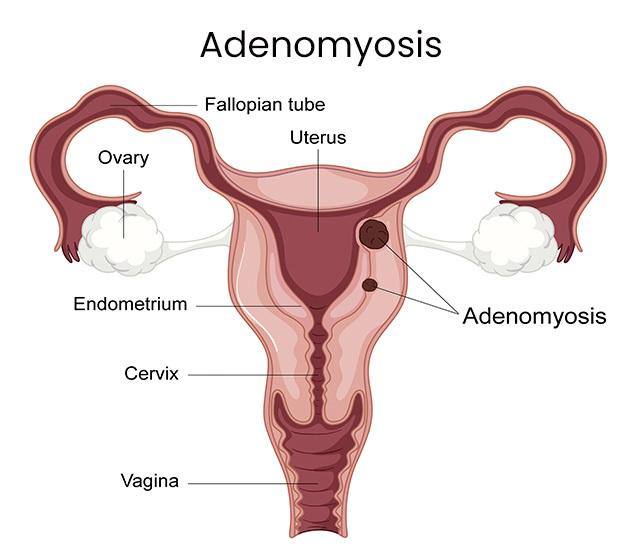You may not know you have adenomyosis as this condition does not always cause symptoms, or the symptoms are usually mistaken for abnormal menstruation. If you have prolonged, heavy bleeding or severe cramping during periods or abdominal and pelvic pain is affecting your regular activities, do not delay seeing a doctor. At Downtown Vein & Vascular Center, Dr. Sergei A. Sobolevsky focuses on making an accurate diagnosis after evaluating your signs and symptoms and recommends the best treatment options based on your unique needs and long-term wellness. The endovascular specialist uses state-of-the-art, innovative techniques to put you on a quick road to recovery.
Adenomyosis is often mistaken for uterine fibroids due to the similarity of the symptoms both conditions share. However, both these conditions are very different. While uterine fibroids are benign tumors that grow in or onto the uterine wall, in adenomyosis, the endometrial tissue that lines the uterus grows into the muscle of the uterus. Accurate diagnosis is the key to determining treatment and relieving painful symptoms.
What Is Adenomyosis?
Adenomyosis is a gynecologic condition in which the tissues in the inner lining of the uterus, known as endometrium, break through or start growing into the muscular wall of the uterus. It enlarges the uterus, sometimes up to double or triple its usual size, and may lead to cramping and very heavy menstrual bleeding. The displaced tissue continues to act normally by thickening, breaking down, and bleeding during each menstrual cycle.
Adenomyosis is not the same as endometriosis, which occurs when the endometrial lining grows outside of the uterus. Women with adenomyosis may also have or develop endometriosis.
Healthcare experts are not sure what causes adenomyosis, but it usually resolves after menopause. Hormonal treatment and removal of the uterus can help women who experience severe discomfort from adenomyosis.

Read more: What are Degenerating Fibroids?
Causes of Adenomyosis?
The exact causes of adenomyosis are still unknown. Studies suggest that women with a family history of the condition or those who have had prior uterine surgery may be at risk for adenomyosis.
There are several theories about what causes this condition.
They include:
- Invasive growth of endometrial cells into the uterine wall that occurs due to an incision made in the uterus during surgery, such as a cesarean birth or during normal uterine functioning
- Uterine inflammation that results after childbirth which breaks the usual boundaries of the cells that line the uterus
- Extra tissues in the uterine wall which are present before birth and grow during adulthood
- Stem cells in the myometrium, or uterine muscle wall
In addition to this, changes in estrogen hormone levels may trigger the condition. This problem usually goes away on its own after menopause.
Symptoms
Symptoms of adenomyosis can be mild to severe. Some women may not experience any symptoms at all.
The most common symptoms include:
- Enlarged uterus
- Heavy or prolonged menstrual bleeding
- Painful menstrual cramps
- Blood clots during menstrual bleeding
- Pain during sexual intercourse
- Abdominal distension due to enlarged uterus
- Chronic pelvic and abdominal pain
- Infertility
An enlarged uterus caused by adenomyosis can result in the following symptoms:
- Constipation
- Frequent urination
- Bloating
- Fertility problems
- Abnormal vaginal bleeding
- Back pain
Many women fail to realize they have adenomyosis as symptoms are often similar to that of a heavy period and do not cause significant complications.
Read more: Signs and Symptoms of Blood Clots
Diagnosing Adenomyosis
Because the symptoms of fibroids and adenomyosis are so similar, misdiagnosis is common. Your doctor may suspect adenomyosis based on the signs and symptoms you are having as well as your medical history. The first step to diagnosing adenomyosis is a physical exam. Your healthcare provider can detect an enlarged and tender uterus during a pelvic exam.
Your doctor may order an ultrasound to see the uterus, its lining, and muscular wall to make a diagnosis. Even though the ultrasound cannot definitively diagnose adenomyosis, it can help to rule out other conditions with similar symptoms.
An MRI of the lower abdomen can confirm the diagnosis in women with abnormal uterine bleeding or evaluate the severity of the condition. In some cases, your doctor may recommend sonohysterography to help evaluate the symptoms associated with adenomyosis. During this process, a saline solution is injected through a tiny tube into the uterus, while an ultrasound is performed.
Read more: What Causes Heavy Periods, and How You Can Stop Them?
Treatment for Adenomyosis
A mild form of adenomyosis may not require treatment. Some women with mild symptoms choose to manage adenomyosis non-surgically until they enter menopause. However, if your symptoms turn serious and begin to affect your daily activities or quality of life, the doctor may recommend options to alleviate your discomfort.
Treatments that help to reduce the severity of symptoms include:
Anti-inflammatory medications – Your doctor may prescribe NSAIDs to relieve mild pain associated with adenomyosis. The medications are meant to be started one or two days before your period begins and continued through the first few days to reduce menstrual blood flow and control the pain and inflammation.
Hormone therapy – Combined estrogen-progestin birth control pills, hormone-containing patches, or vaginal rings might lessen excessive bleeding and pain associated with adenomyosis. Progestin-only contraception, such as an intrauterine device, or continuous-use birth control pills, can stop menstruation, which may provide some relief.
Uterine artery embolization – It is a minimally invasive procedure that prevents certain arteries from supplying blood to the affected area. As the blood supply is cut off, the adenomyosis shrinks. This process is usually used for treating uterine fibroids but helps with adenomyosis too.
Endometrial ablation – This minimally invasive procedure removes or destroys the endometrium or lining of the uterus. It is effective in relieving symptoms in women when adenomyosis has not penetrated deeply into the muscle wall of the uterus.
Hysterectomy – If your pain is severe and no other treatment is working, your doctor may recommend surgery to remove the uterus. It is the only way to completely cure adenomyosis which involves complete surgical removal of the uterus.
Many women who experience life-disrupting symptoms from adenomyosis find relief through treatment. Symptoms usually go away after menopause, but you may still have an enlarged uterus. Several factors will determine which course of treatment is the best for you, including your age, risk factors, medical history, and the severity of your symptoms.
Preventing Adenomyosis
As the exact cause of adenomyosis is unknown, there are no known ways to prevent it. An annual physical check, pelvic examination, and cervical cancer screening can help to detect the abnormality early and find the best solution.
Menstrual bleeding and adenomyosis
Normal menstrual bleeding is:
- Less than 80 cc blood flow per day
- Only the first 3 days of heaving bleeding
- Does not last longer than 7 days
- Bean-sized blood clots
Adenomyosis can lead to excessive or prolonged menstrual bleeding, lasting up to 2 weeks or more. It also causes severe cramping or sharp knifelike pelvic pain during menstruation, along with an enlarged uterus. You may have adenomyosis and not know about it, as these signs vary from person to person, and are shared with many other conditions. No two women with adenomyosis are alike. It means treating this condition is not the same for everyone.
Although adenomyosis is not a serious problem or causes any lasting complications, heavy bleeding, pain, and discomfort can disrupt your daily life. It often causes difficulty conceiving or miscarriage if it is not treated timely. It is not something you have to live with, as there are many options to ease its symptoms. At Downtown Vein & Vascular Center, you can look forward to working with specialists who are experts at diagnosing and treating all conditions related to reproductive health. Dr. Sergei A. Sobolevsky evaluates your symptoms, analyzes your condition, and comes up with the best treatment options to alleviate your discomfort and improve your quality of life.

Sergei Sobolevsky, MD, is a leading specialist in endovascular medicine with experience in vascular and interventional radiology. Dr. Sobolevsky has decades of experience in the field, with over 25,000 procedures performed, accumulating extensive experience in image-guided minimally invasive medicine, diagnosing and treating a range of conditions.
Dr. Sobolevsky earned his Doctor of Medicine (MD) degree in 1997 from the University of Colorado School of Medicine. He received his specialty clinical training in vascular and interventional radiology at Harvard University. Later, he earned his MBA from the MIT Sloan School of Management. Recognized as a Castle Connolly Top Doctor and named to the Top Doctors New York Metro Area in 2020, 2021, and 2022, Dr. Sobolevsky is licensed in multiple states, has delivered presentations at numerous institutions in the US and abroad, and now acts as a clinical advisor for the biomedical industry. He also held multiple positions in the field during his career, including Chief of Vascular and Interventional Radiology at the Columbia University Medical Center in New York, NY, Senior Vice President in Clinical and Regulatory Affairs at Artann Laboratories in North Brunswick, NJ, and Medical Director at the American Endovascular and Amputation Prevention Center in Brooklyn.
More About Dr. Sobolevsky

